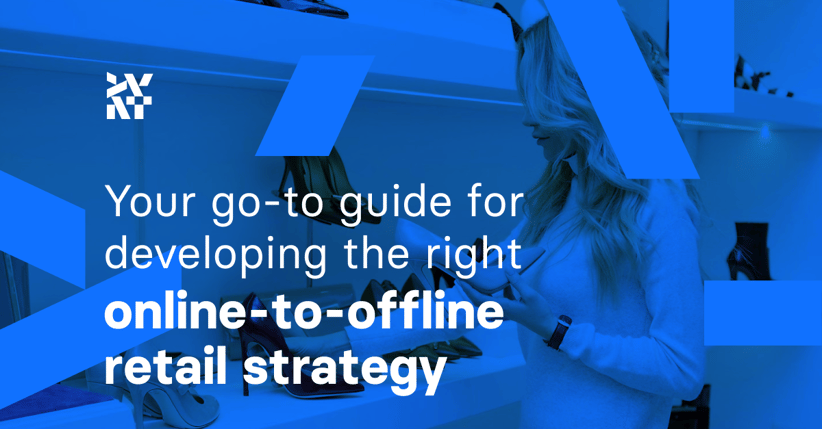With digital transformation and the not-too-recent COVID-19 pandemic, retailers now find it easy to adopt online channels for their business. However, retailers are eager to boost sales by attracting customers to their physical stores, too. They recognize how crucial it is to connect with and care for their customers and how doing so can enhance customer experience while also bringing in more revenue. This helped lead to the opening of more than 8,000 stores in 2021.
To encourage online shoppers to visit physical stores, it’s necessary to implement an online-to-offline retail strategy, which is a comprehensive approach for eCommerce businesses. In this guide, we’ll define the online-to-offline retail strategy, how to implement it, and tell you what its benefits are.
What is online-to-offline retail strategy?
Online-to-offline (O2O) retail strategy is a business model designed to bring both existing and potential customers from online retail platforms to your brick-and-mortar store to increase sales. Since customers often switch between online and offline channels when buying, this retail strategy helps drive more engagement and revenue to the physical stores.
How does O2O work?
Although online retail stores enjoy high visibility with different ranges of products and prices, no online convenience can compare to the sense of confidence and fulfillment that customers get when they visit a physical retail store. They get to see and feel a product before buying it. For instance, when purchasing fashion items, most customers prefer visiting physical stores rather than online stores.
Source: Pexels
An O2O retail strategy is not independent of online channels. Instead, it helps to bridge the gap between online and offline retail stores by integrating both channels. According to reports, over 70% of consumers will purchase at a physical location rather than buy online if there’s a pressing need for the product.
By using an O2O retail strategy, retailers can promote their products and services online for potential customers to search for what they need. They can also place their orders and then visit the brick-and-mortar store to pick them up.
Benefits of O2O strategy
Positive customer experience
Retailers with online and offline channels provide high levels of customer experience. However, shoppers often prefer physical stores because they get first-hand experience of what your products and services feel like in person. It also allows customers to interact with salespeople and express themselves until their demands are met.
An O2O retail strategy strengthens relationships, ensures you listen and understand your customers, and shows your business is the best at serving their needs. Providing the right product at the right time creates an unrivaled customer experience that fosters brand loyalty.
Reduce cost
An O2O retail strategy is a great way to cut costs on your overall business processes. For instance, in the area of logistics, which is vital to the success of eCommerce as you expand, an O2O retail strategy facilitates the online buying and in-store pick-up model for retailers. This helps retailers lower those costs.
Improve customer retention
A well-executed O2O retail strategy keeps customers returning to the store from time to time. The value and satisfaction received from interacting with employees can outperform online services.
It portrays your business as a consumer-centric enterprise, and building upon this value will help retain buyers. Engaging customers with discount coupons, in-store competitions, QR codes, and eCommerce loyalty programs can inspire new and existing buyers to visit your brick-and-mortar stores consistently.
Boost brand awareness and sales
An O2O retail strategy brings a different twist to business in terms of awareness and sales. It doesn't follow the conventional method of linear online purchase. Instead, it complements the process.
Remember, not every passerby will visit your brick-and-mortar stores when they get the chance to visit. However, retailers can use online channels such as social media platforms, review aggregators, and search engine optimization to build target audiences around their physical stores. That’ll result in more customers, more sales, and better your brand’s awareness.
How to develop an online-to-offline retail strategy
Here are four steps for developing an O2O retail strategy that’ll help eCommerce businesses thrive.
1. Set your goals
According to Statista, online purchases are rising, and this won’t stop anytime soon. Correspondingly, getting online consumers to visit your brick-and-mortar store won’t be easy, so you need to set goals. By using key performance indicators (KPIs), you can understand where your business is and what it aims to accomplish with an O2O retail strategy.
Examples of goals you could consider could be developing a successful online campaign to boost sales in physical stores, creating more brand awareness, or opening your first physical store because it's necessary for the kind of products and services your business offers. These goals, among others, can be achieved by using an O2O retail strategy.
2. Create measurable plans
With your goals set, it's important to create actionable plans that’ll help your business meet its targets. Breaking down these goals into smaller objectives can help you achieve this.
Make sure these objectives follow a goal framework by being specific, measurable, attainable, relevant, and time-bound (SMART) while being consistent with your long-term business goals. This will ensure you remain focused on achieving quantifiable and realistic goals and not just mere expectations or wishful thinking.
3. Understand consumers’ behavior
You can't understand your customers' behavior without analyzing their data. Data analysis gives you insight into customers’ behavior, such as their spending habits, preferences, and buying patterns. It helps you learn what you're doing right online and how it's applicable offline. Studying your competitors' products, customer satisfaction rates, marketing techniques, and other factors will also help you get the most out of your data research.
Knowing how your customers behave keeps you up-to-date on current market trends, customer segmentation, and demographics and will help you spot possible loopholes before they materialize. With this knowledge, you can build a retail employee scheduling strategy to boost staff efficiency in your brick-and-mortar store that will bridge the gap between your customers and their preferred products.
4. Execute strategies
This is where you use all the information and data obtained from the previous stages to implement the O2O retail strategy. For example, by using regional inventory, businesses can have strategic locations to serve as storage places for customers to pick up products bought online. Doing this increases your brand’s reputation because shoppers can rely on you to get their products from the physical stores on the same or next day for pick up.
Marketing can take a different approach when compared to previous methods. You can adopt new types of social media posts or advertisements to attract a larger and more specific audience. That’ll ensure your customers get the best in-store experience.
Takeaways
This guide shows that an O2O retail strategy is the future of eCommerce because of the numerous benefits for the retailer. If done right, it combines the online and offline channels to give customers a great shopping experience that leaves them returning for more. By adopting this strategy, businesses can bring customers to their offline stores, and that’ll help them improve on all fronts.
Published October 20, 2022











